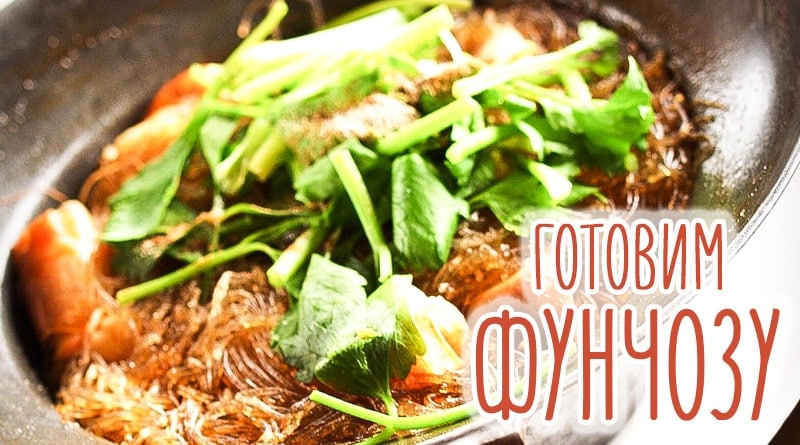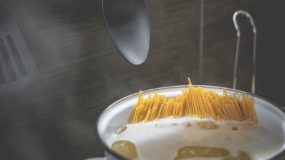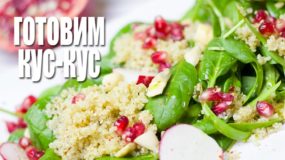Asian cuisine is original. One of the unusual dishes is Funchosa bean noodles. There are many recipes for making funchose at home, because it belongs to universal products, and is combined with various spices, vegetables, poultry, meat.
Preparation for cooking
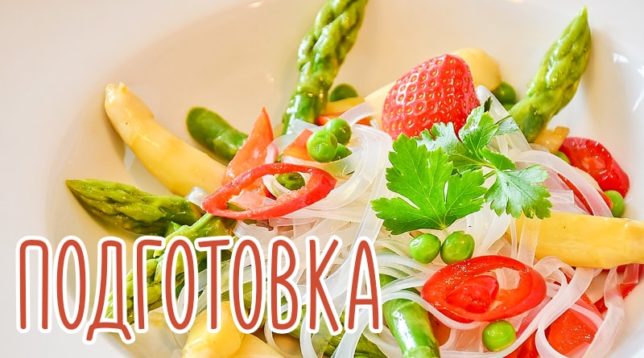
The product is based on starch obtained from golden mung bean. The spread of funchose in the world began from China, so it is still considered a national Chinese dish. Mung bean is also grown in India, Korea, and Japan. Thus, it is possible to combine opinions and say with confidence that the fungoza comes from Southeast Asia.
Due to the fact that it is made from starch, it received the second name - glass or starch noodles. And this is not surprising, because after cooking, it presents thin, white threads of a transparent (glass) appearance.
The composition includes not only starch mung, but also other leguminous crops: yams, cassava, cain.
How to cook
Funchoza can be used in the preparation of first, second courses, salads or side dishes. It is prepared easily - pour dry noodles into boiling water, boil for 3-5 minutes, put in a colander and rinse with cold water.
You can not cook, but simply pour boiling water, and let it brew for 15-20 minutes.
The most popular recipes with chicken, fresh carrots and cucumbers. Serve on the table in a warm form. The cooled noodles stick together and lose their appearance.
Korean-style classic fungoza with vegetables

- funchose 150 g
- carrot 1 PC
- cucumber 1 PC
- garlic 4 tooth.
- parsley 1 twig
- dill 1 twig
- olive oil 3 Art. l
- dry spices (dried garlic, red and black ground pepper, ground coriander) 2 tsp
- salt taste
- Vermicelli is soaked in hot water for 5-7 minutes.
- Leans back in a colander, rinsed in cold water and gives time to excess glass water.
- Vegetables are prepared: carrots and cucumbers are chopped with a thin straw. It is better to buy a special grater for Korean salads. The greens and garlic are chopped as finely as possible.
- Chopped carrots are placed in a separate container and mixed by hand until juice appears.
- Dressing is being prepared: all spices, salt, vinegar, olive oil are mixed.
- In a separate container, noodles are connected with all products, everything is filled with dressing. Then the contents are thoroughly mixed.
- For final readiness, the dish is left for 2 hours to insist.
Korean-style classic fungoza with vegetables is ready. Can be served.
Chicken recipe in a pan
- half-pack of glass noodles;
- 1 large carrot;
- head of red onion;
- 220 g chicken;
- 15-20 g of fresh garlic;
- 40-45 ml of soy sauce;
- one third of a teaspoon of Five Spice Chinese seasoning;
- 10 g sesame toasted seeds;
- 30 ml of sesame oil.
- Chicken fillet is cut into elongated, thin slices, dried on a paper napkin.
- Vegetables. First, onions and carrots are peeled, then chopped with a thin straw. To grind the root crop, it is better to use a “roko” grater, and for onions - a shredder grater.
- Funchoza.It is poured into a separate container, poured with steep boiling water, and closed with a lid. It should be infused for 5 minutes. To glass water, it is placed in a colander.
- Preparation of the pan: put on maximum heat, let it warm up, add sesame oil, heat for 2 minutes. Then pour onion, fry for 2 minutes.
- After the onions are ready, chicken pieces are placed in the pan. Meat with onions should be fried for 8 minutes with constant stirring.
- After the meat is put carrots, roasted for another 4 minutes. After this time, noodles are added. All products are thoroughly mixed and roasted for 2 minutes. After that you can turn off the fire.
- Before serving, add spices. Pour soy sauce, grated garlic, sesame seeds. If desired, you can put finely chopped greens.
- The pan is closed with a lid, the contents are infused for 5 minutes.
Chicken and Vegetable Fungose Salad
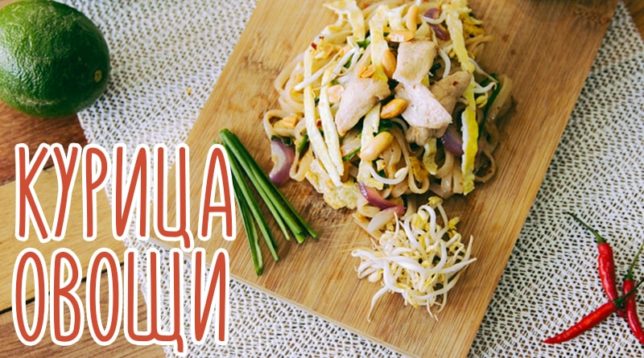
- vegetables: 2 potato tubers, 1 carrot, 1 head of onion, 4 cloves of garlic;
- sauces: soy - 6 tablespoons, oyster - 2 tablespoons;
- spices: 1 teaspoon of grated ginger, dried chili pepper and sesame, black pepper and salt to taste;
- chicken - 1 piece, weighing (1.5-2 kg);
- funchose noodles - 100 g;
- oyster mushrooms - 200 g;
- stalks of green onions - 4 pieces;
- rice wine - 2 tablespoons;
- sesame oil - 1 tablespoon;
- plain water - 600 ml.
- Sauce. Pour soy sauce in one container, add the garlic passed through the press. Then put grated ginger, pepper, salt, oyster sauce, rice wine. If this is not, you can replace the usual dry grape.
- Chicken. The carcass is thoroughly washed and chopped into small pieces. It is placed in a saucepan, poured with sauce, put on fire. When the sauce boils, the fire is reduced to a minimum. The pan is covered and left for 15 minutes.
- Noodles are cooked using the technology described above.
- Vegetables. They are cleaned, washed, cut into large slices. Add to the chicken pan.
- All ingredients are thoroughly mixed, boiled until vegetables are ready.
- When the contents are ready, add sesame oil, sesame, funchose.
- The pan is closed with a lid and left until fully cooked for 2-5 minutes.
Before serving, lay the green onions.
Glass noodles with meat and vegetables
The recipe is designed for two people. The composition does not contain salt, because soy sauce will give the meat a unique taste and replace it.
- 2 hanks of noodles;
- 1 kg of pork;
- onions - 3 heads;
- carrot - 1-2 pieces;
- 1-1.5 tea glasses of soy sauce;
- 1 tsp ground coriander;
- vegetable oil - for frying meat;
- water.
- Noodles are prepared in the usual way.
- Pork is washed, dried on a paper towel, cut into long, thin strips.
- Vegetable oil is poured into the pan, put on a fire for heating. Meat is laid out in it, fried for 15-20 minutes. In the process, pork releases juice, so it is better to fry in an open pan.
- After 5-10 minutes, soy sauce is poured, the fire is reduced to a minimum. In this mode, the contents should boil. When the gravy boils, the container closes with a lid, stews for 15-20 minutes.
- When the pork becomes soft, they add pre-chopped onions, grated Korean carrots.
- Under a lid over low heat everything is extinguished until fully cooked.
- To serve, take a plate, put a portion of funchose, pork on top, pour gravy from soy sauce. It is advisable to add fresh or pickled vegetables.
Seafood Recipe
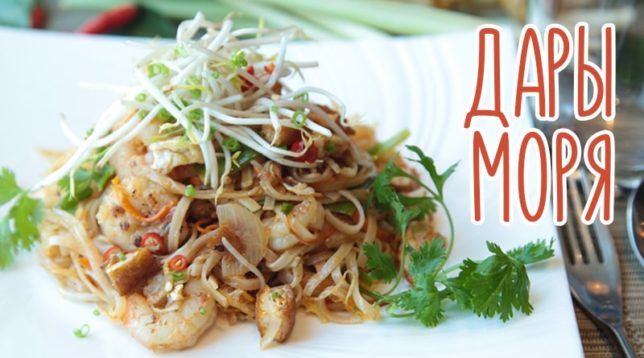
Culinary experts say that pasta with seafood is always tastier if there are a lot of them.
- 100 g of funchose;
- sweet pepper - 2 pcs.;
- cherry tomatoes - 5 pcs.;
- onions - 1 head;
- 2 cloves of garlic;
- frozen green peas - 50 g;
- 500 grams of seafood cocktail;
- 1 kg king prawns;
- 1 tablespoon of olive oil;
- 2 tablespoons of soy sauce.
- Prepare funchose according to a known recipe.
- Boil shrimp. If with a shell, then clean after boiling. If already peeled, then 500 grams is enough. Cook no more than 2 minutes.
- Onions and garlic are peeled, finely chopped. Pepper washes, cut into strips.
- Put onion and garlic in a pan, add oil, fry for 3 minutes over high heat, stirring constantly.
- When the onions and garlic are ready, vegetables are added. After everything is fried for about 5 minutes.
- When the vegetables are fried, they put pasta, sauce, ground pepper, everything is thoroughly mixed.
- At the last stage, a seafood and shrimp cocktail is added.
- Stir the dish over low heat for 7-10 minutes.
How to make funchose soup
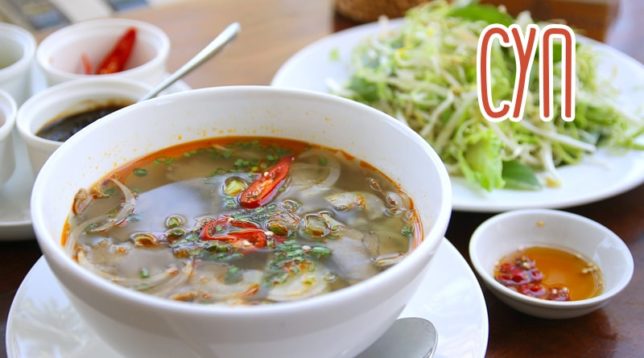
The recipe is simple and powerful even for a novice hostess.
- 350-400 g chicken;
- 100 g of noodles;
- 1 onion;
- 100 g of Beijing cabbage;
- salt and pepper to taste.
- We process the chicken fillet, wash it, put it in a pan with water. After boiling, salt and cook for 30-40 minutes.
- While the fillet is cooked, chop the vegetables.
- We take out the finished chicken from the pan, cut it in portions.
- Put funchose into the broth, boil for 7-10 minutes.
- Add chicken slices to the soup, simmer over low heat. Before serving, you can put fresh herbs.
The benefits and harms of funchose
Glass noodles have properties that are both beneficial to the body and harmful.
The composition contains B vitamins that stabilize the nervous system, vitamin PP, which improves the state of the circulatory system. It contains amino acids that contribute to the formation of new cells.
The product is recommended for the diet of people with allergies, because it lacks gluten. It is widely used in diets because it contains a minimal amount of fat.
However, the fungoza itself is tasteless, and is usually used in conjunction with various sauces. And here you need to be careful. Many spices are forbidden to eat for people suffering from chronic diseases of the stomach, pancreas and liver. Sour, spicy and even sweet sauces can cause harm to health.
Calorie content
Dry calorie content is quite high. 100 grams contains about 335 kcal. If you cook, calorie content drops sharply to 85 kcal per 100 grams.
Given that funchose is not eaten separately, the calorie content of the finished dish depends on all the ingredients. For example:
- with mushrooms - 105 cocoa;
- with vegetables - 100 kcal;
- with pork - 150 kcal;
- with beef - 135 kcal;
- with cheese - 120 kcal.
The most high-calorie dishes with pork.
Useful tips and interesting information.
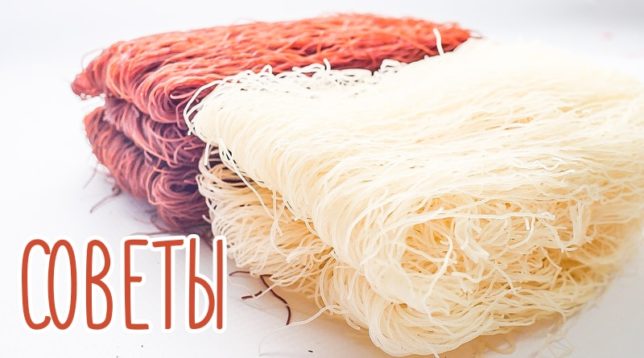
In order to cook funchose properly, culinary experts give some useful tips.
- The pasta sticks when it cools. To prevent this process, add 1 tablespoon of vegetable or olive oil for every liter of water during cooking.
- Rinse noodles with cold water only. This also reduces the risk of sticking.
- Cut into separate pieces after cooking. If cut dry, it will crumble.
- Cooked noodles go bad quickly, so cook as much as you eat at a time.
Chinese culinary experts consider funchose as the basis of longevity. Eastern legends claim that Japanese ninjas replenished their strength with just this noodle.
Only natural product has healing properties. Many, not understanding it, confuse it with rice noodles. In appearance, they are similar, only rice is made from rice flour, and after processing it acquires a milky white color.

